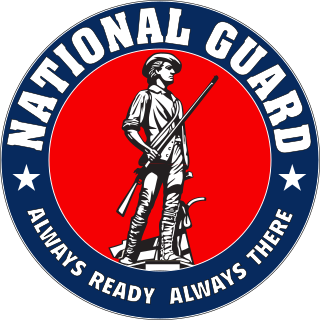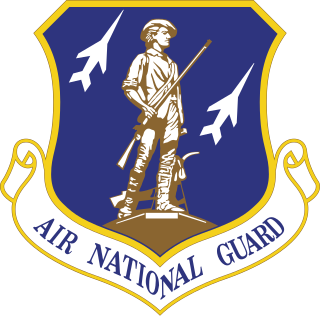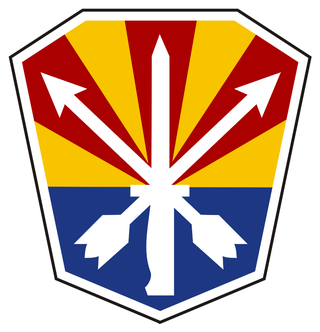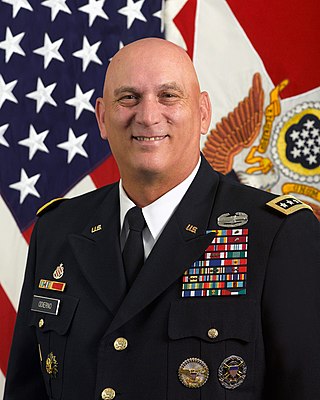
The National Guard is a state-based military force that becomes part of the US military's reserve components of the US Army and the US Air Force when activated for federal missions. It is a military reserve force composed of National Guard military members or units of each state and the territories of Guam, the Virgin Islands, Puerto Rico, and the District of Columbia, for a total of 54 separate organizations. It is officially created under Congress's Article 1 Section 8 ability to "raise and support armies". All members of the National Guard are also members of the organized militia of the United States as defined by 10 U.S.C. § 246. National Guard units are under the dual control of state governments and the federal government.

The Air National Guard (ANG), also known as the Air Guard, is a federal military reserve force of the United States Air Force, as well as the air militia of each U.S. state, the District of Columbia, the Commonwealth of Puerto Rico, and the territories of Guam and the U.S. Virgin Islands. It, along with the Army National Guard component of each state, district, commonwealth or territory, makes up the National Guard of each region as applicable.

The United States Coast Guard Reserve is the reserve component of the United States Coast Guard. It is organized, trained, administered, and supplied under the direction of the Commandant of the Coast Guard through the Assistant Commandant for Reserve (CG-R).
In the United States military, stop-loss is the involuntary extension of a service member's active duty service under the enlistment contract in order to retain them beyond their initial end of term of service (ETS) date and up to their contractually agreed end of active obligated service (EAOS). It also applies to the cessation of a permanent change of station (PCS) move for a member still in military service. Stop-loss was used immediately before and during the 1990–91 Persian Gulf War. Since then, it has been used during deployments to Somalia, Haiti, Bosnia, Kosovo and after the September 11 attacks and the subsequent War on Terror.

The Air Force Reserve Command (AFRC) is a major command (MAJCOM) of the United States Air Force, with its headquarters at Robins Air Force Base, Georgia. It is the federal Air Reserve Component (ARC) of the U.S. Air Force, consisting of commissioned officers and enlisted airmen. Together, the Air Force Reserve and the Air National Guard constitute the Air Force element of the reserve components of the United States Armed Forces. AFRC also plays an integral role in the day-to-day Air Force mission and is not strictly a force held in reserve for possible war or contingency operations. AFRC also supports the United States Space Force through the 310th Space Wing, pending the creation of a space reserve component.

The United States Navy Reserve (USNR), known as the United States Naval Reserve from 1915 to 2005, is the Reserve Component (RC) of the United States Navy. Members of the Navy Reserve, called Reservists, are categorized as being in either the Selected Reserve (SELRES), the Training and Administration of the Reserve (TAR), the Individual Ready Reserve (IRR), or the Retired Reserve.

A reservist is a person who is a member of a military reserve force. They are otherwise civilians, and in peacetime have careers outside the military. Reservists usually go for training on an annual basis to refresh their skills. This person is usually a former active-duty member of the armed forces, and they remain a reservist either voluntarily, or by obligation. In some countries such as Israel, Norway, Finland, Singapore, and Switzerland, reservists are conscripted soldiers who are called up for training and service when necessary.

Military recruitment refers to the activity of attracting people to, and selecting them for, military training and employment.

The Arizona Army National Guard is a component of the United States Army and the United States National Guard. National coordination of various state National Guard units are maintained through the National Guard Bureau.

The Florida Army National Guard is Florida's component of the United States Army and the United States National Guard. In the United States, the Army National Guard comprises approximately one half of the federal army's available combat forces and approximately one third of its support organization. Federal coordination of various state National Guard units are maintained through the National Guard Bureau. The Florida Army National Guard was composed of approximately 10,000 soldiers. The main state training grounds is Camp Blanding.

A military reserve force is a military organization whose members (reservists) have military and civilian occupations. They are not normally kept under arms, and their main role is to be available when their military requires additional manpower. Reserve forces are generally considered part of a permanent standing body of armed forces, and allow a nation to reduce its peacetime military expenditures and maintain a force prepared for war. During peacetime, reservists typically serve part-time alongside a civilian job, although most reserve forces have a significant permanent full-time component as well. Reservists may be deployed for weeks or months-long missions during peacetime to support specific operations. During wartime, reservists may be kept in service for months or years at a time, although typically not for as long as active duty soldiers.

Raymond Thomas Odierno was an American military officer who served as a four-star general of the United States Army and as the 38th chief of staff of the Army. Prior to his service as chief of staff, Odierno commanded United States Joint Forces Command from October 2010 until its disestablishment in August 2011. He served as Commanding General, United States Forces – Iraq and its predecessor, Multi-National Force – Iraq, from September 2008 through September 2010.

The Iowa Army National Guard is a state agency of the State of Iowa, with significant funding from the Federal Government of the United States; and a reserve component of the United States Army. It has dual Federal and State missions. It is empowered to function under control of the Governor, as a State asset in times of emergency or natural disaster, or if needed to carry out limited actions during non-emergency situations to include full scale Enforcement of martial law, when local law enforcement officials can no longer maintain civil control. The National Guard may also be called into federal service in response to a call by the President or Congress.

Battle Assembly is the term used by the United States Army Reserve to describe monthly training, where soldiers practice and perfect their military skills and maintain individual and unit readiness in the event of mobilization and deployment. These training activities were formerly referred to simply as "drill" or "weekend drill", but according to former Chief of the Army Reserve, Lieutenant General James R. Helmly, the term was changed in 2005 to emphasize the need for Army Reserve soldiers' training to focus on continued preparation for fighting the Global War on Terrorism.

The Louisiana Army National Guard is a component of the Louisiana National Guard, and the state's reserve force within the United States Army. The Constitution of the United States specifically charges the National Guard with dual federal and state missions. When not federalized, the National Guard is the only United States military force empowered to function in a state status. Those functions range from limited actions during non-emergency situations to full scale law enforcement of martial law when local law enforcement officials can no longer maintain civil control. The Louisiana Army National Guard may be called into federal service in response to a call by the President or U.S. Congress.

The Wyoming Air National Guard (WY ANG) is the aerial militia of the State of Wyoming, United States of America. It is, along with the Wyoming Army National Guard, an element of the Wyoming National Guard.

The Marine Forces Reserve, also known as the United States Marine Corps Reserve (USMCR) and the U.S. Marine Corps Forces Reserve, is the reserve force of the United States Marine Corps. It is the largest command, by assigned personnel, in the U.S. Marine Corps. Marines in the Reserve go through the same training and work in the same Military Occupational Specialties (MOS) as their active-duty counterparts. The United States Marine Corps Reserve was established when Congress passed the Naval Appropriations Act of 29 August 1916, and is responsible for providing trained units and qualified individuals to be mobilized for active duty in time of war, national emergency, or contingency operations.
The reserve components of the United States Armed Forces are military organizations whose members generally perform a minimum of 39 days of military duty per year and who augment the active duty military when necessary. The reserve components are also referred to collectively as the National Guard and Reserve.

The Kentucky Army National Guard is a component of the United States Army and the United States National Guard. Nationwide, the Army National Guard comprises approximately one half of the US Army's available combat forces and approximately one third of its support organization. National coordination of various state National Guard units are maintained through the National Guard Bureau.

An officer is a person who holds a position of authority as a member of an armed force or uniformed service.


















